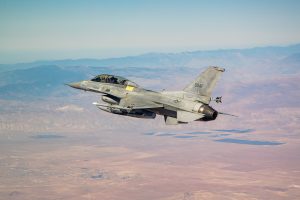The China-U.S. tensions over Taiwan are not new, but recent events have cast a harsher light on the fragility of the situation. Despite attempts at dialogue, like National Security Adviser Jake Sullivan’s visit to Beijing in late August, the Chinese government’s reaction to U.S. arms sales to Taiwan has been swift and severe.
On September 18, China’s Ministry of Foreign Affairs imposed sanctions on nine U.S. defense companies over a $228 million arms sale, announced by the U.S. State Department on September 16, that involved the return, repair, and reshipment of spare parts for Taiwan. The announcement came just before a U.S. Navy P-8A Poseidon transited the Taiwan Strait on September 17.
In response, China’s Ministry of Defense doubled down on September 20, warning both Taiwan and the United States that U.S.-made weapons would not safeguard Taiwan’s Democratic Progressive Party (DPP), but would instead directly lead to “self-destruction” – a stark reminder of the increasing hostility and rhetoric surrounding Taiwan’s defense.
The September 16 announcement marks the 16th arms sale to Taiwan under the Biden administration, yet doubts continue to mount over the United States’ true commitment to Taiwan’s security. The Biden administration’s sales have primarily consisted of munitions and sustainment packages delivered in small tranches, failing to address Taiwan’s need for a comprehensive modernization of its military, especially in comparison to China’s rapid space of military modernization.
According to Rupert Hammond-Chambers, the president of the US-Taiwan Business Council, the Biden administration appears to be avoiding more substantial military commitments to Taiwan, reminiscent of pre-Trump era policies that capped the value of arms sales to avoid provoking Beijing. In a press release, Hammond-Chambers warned that “U.S. support for Taiwan’s material force modernization has been waning since 2021. It now sits at its lowest point since 2001, bar the Obama Administration’s 4+ year arms sales freeze from 2011-2015, and it is continuing to fall.”
Recent arms deliveries have also been fraught with problems. A $345 million arms package delivered between November 2023 and March 2024 included unserviceable and expired equipment, some of which was found to be mildewed and water-damaged, according to a report published on September 11 by the Inspector General Office of the U.S. Department of Defense. These revelations undermine the credibility of U.S. commitments to Taiwan and raise serious questions about the effectiveness of these sales in enhancing Taiwan’s defense capabilities.
More advanced and lethal systems, such as F-16Vs, have faced significant delays, adding to a backlog of $20 billion in undelivered military hardware. U.S. officials have attributed these delays to the urgent demands of the war in Ukraine, suggesting that Washington’s priorities lie elsewhere, particularly in Europe, rather than in the Indo-Pacific region. This prioritization was further underscored by the urgent redeployment of the USS Lincoln from the West Pacific to the Arabian Sea in early August, leaving a significant gap in aircraft carrier presence in the region that remains unfilled.
The restrained and fragmented nature of U.S. arms supplies to Taiwan sends mixed signals at a time when Beijing’s military posture is increasingly aggressive. China’s Ministry of Defense has pledged that the People’s Liberation Army (PLA) will continue to intensify its military training and preparations, and will take decisive measures to thwart any attempts at “Taiwan independence” or external interference. China’s actions are not merely rhetorical; they underscore a clear strategy to pressure Taiwan and the United States by both escalating military readiness and undermining the credibility of U.S. security guarantees to Taiwan.
Meanwhile, China appears to be taking calculated steps to marginalize the Taiwan issue in its broader strategic relationship with the U.S., particularly during the sensitive U.S. presidential election cycle. With polls showing a close race between Donald Trump and Kamala Harris, Beijing has publicly maintained a non-interventionist stance, framing the U.S. election as a domestic affair. However, behind the scenes, China is hedging its bets, preparing to navigate both potential outcomes. In the event of a Trump victory, Beijing appears ready to endure economic sacrifices in exchange for strategic leverage, anticipating a transactional approach from a second Trump administration regarding Taiwan.
Conversely, Beijing is also exploring opportunities to proactively build diplomatic consensus with Harris, should she win, possibly through side discussions with President Joe Biden at the upcoming APEC and G-20 summits in South America this November. Given Harris’ inexperience on foreign policy, China will be aiming to influence her potential administration.
Meanwhile, Beijing is believed to continue strengthening military and political alignment with Russia, thereby complicating U.S. and allied presence in the Western Pacific, and bringing in a Russian factor into potential Taiwan contingency that has been repeatedly mentioned by the United States and Japan in particular. This strategic positioning serves China’s broader goal of diminishing U.S. influence in the region and enhancing its own sphere of control.
The consequences of this restrained U.S. approach are stark. Taiwan finds itself in a security dilemma, relying on a defense partner whose commitment appears inconsistent, while facing a China that is more emboldened than ever. This imbalance heightens the risk of miscalculations and unintended confrontations in the Taiwan Strait, with potential implications that stretch far beyond the immediate region.
As the United States continues to navigate its broader geopolitical priorities, Taiwan remains caught in a perilous position, where the gaps in its defense capabilities are increasingly visible. The situation illustrates the broader challenges of managing great power competition in a multipolar world where the stakes are high and the margins for error are dangerously thin. The ongoing tensions are not just a test of military resolve but also of strategic stability in the Indo-Pacific, setting the stage for a potentially transformative period in regional security dynamics.

































